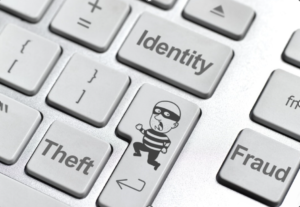In 2021, AARP found that identify theft had affected more than 42 million U.S. consumers. This resulted in a loss of $52 billion. The Aite Group predicts that damages from this threat vector could reach a staggering $625.4 billion by 2023. The explosive growth of this crime will continue to increase as we spend more of our lives online. Each day people post a plethora of information to social media platforms, giving bad actors plenty of opportunity to steal personal data.

What is Identity Theft?
The DOJ defines identity theft as “all types of crimes in which someone wrongfully obtains and uses another person’s personal data in some way that involves fraud or deception, typically for economic gain.” The consequences for individuals targeted vary and can often be severe. These crimes can result in significant debt, poor credit, and a damaged reputation.
PII 101
Criminals looking to steal identities specifically target personally identifiable information (PII). PII is any information that can identify an individual including date of birth, driver’s license numbers, employment information, personal address, and Social Security numbers (SSN). If a criminal has enough of these elements, they can quickly be used in identity theft. This means that it is vital that your personal information is protected from unauthorized access or disclosure.
Once a criminal has this information, they can use it in various ways.
- Financial identity theft/fraud: Stealing credit card information to purchase goods, using other PII to apply for loans, obtain benefits, or file for tax refunds. All of which leaves the victim responsible for any incurred costs or fees.
- Medical Identity theft: Stealing PII to obtain prescription drugs, see a doctor, or purchase medical devices.
- Synthetic Identify Theft: Using a real person’s SSN combined with a fake identity to obtain a loan. This is now one of the fastest growing forms of identity theft, with 95% of the crimes going undetected and an average loss of $15,000.
- Child identity theft: Using a juvenile’s PII to commit fraud.
These are just some of the potential opportunities for criminals to exploit your PII. With these multiple avenues available, the results show the magnitude of the problem. In the U.S alone, identity theft occurs every 22 seconds.
Protect Your PII
With these attacks mounting day by day, it is more important than ever to protect your personal information. Following these preventative tips can help you protect yourself.
Use strong passwords and PINs
Never use your birthdate, phone number, or physical address, as your passwords or pin codes. This information is too easy for cybercriminals to find. A good judge of whether your password is secure or not: If your friend or relative can guess your pins, a criminal can too. Using a random password generator that has a mix of letters, numbers, and symbols, is a good form of a secure password. Many password managers include random password generators and can be used to keep track of these passwords.
Limit the information you share online
Social media accounts are a goldmine for cybercriminals. It is important that you check your security settings on all your different social media accounts. Make sure your privacy settings are set so that your information is not listed publicly. Also be cautious of who you add on social media, sticking to those you know personally.
Monitor bank statements and keep your cards safe
Check your bank statements regularly for unrecognized transactions. If something looks fishy, that could mean you’ve already been targeted or your information has been stolen. The sooner you spot the fraudulent transactions, the higher the likelihood of minimizing any losses. When using your cards at an ATM or point of sale portal cover the keypad when you enter your PIN.
Beware of social engineering attacks
Understanding the dangers of phishing schemes and other internet scams help you to know what the criminals are looking for. When you understand how the scams work, you’re better prepared and better protected. We have a series of blogs and newsletters that provide a plethora of information on how to protect yourself from identity theft and other scams. And our Framework article, Identity Thieves, provides an in-depth look at this topic.
Even Small Steps Can Net Bigger Protection
While being prepared is an effective way to be on guard against attacks, there are also identity theft protection services that help monitor your accounts and your PII and will notify you anytime there is any use of these pieces of information. Nasdaq recently broke down the 7 Best Identity Theft Protection Services of July 2023.
The reports of scams can make the task of protecting yourself against scammers seem daunting, but by taking small steps it can mean a bigger net of protection against them. Remember, if you hold yourself dear, protect yourself well.
Written by: Amanda Marchuck
Image: Experian IdentityWorks

